
(Click on image to enlarge)
Sometime during the 1930s, Roland G. and Gladys B. Schmitt quietly bought up farmland that had belonged to two of Ainsworth's long-time residents, Charles Chester and Henry Nolte.[1] If I'm reading the plat map correctly, by 1939 the Schmitts owned some 400 acres. Where, during the Great Depression, would the money for that kind of purchase come from? The answer is: drugs. Roland Godfrey Schmitt was an executive with the expanding drugstore chain, Walgreens.
Born in Warsaw, Illinois, in 1890, he had started with Walgreens when he was just 20 years old and the chain itself not quite 10.
Roland G. Schmitt’s path to and through Walgreens would become a well-worn one, and it is still traveled today. The very day he enrolled in the Illinois School of Pharmacy in 1910, he noticed a “help wanted” announcement on a bulletin board at the school for a part-time apprentice at Walgreen’s first store at the corner of Cottage Grove and Bowen avenues. In the same youthful spirit that Walgreen demonstrated when he hopped on a train from Dixon to Chicago 17 years earlier, Schmitt stepped on a streetcar that afternoon, introduced himself to Arthur Thorsen — who was impressed by the young man’s wit and warmth — and accepted Thorsen’s offer of $8 a week (just $3 more than Walgreen earned after he got off the train almost two decades before).In 1912, Roland married Amanda Schilling. By the 1920 Census — at which time there were 23 stores in the Walgreens Chain[3] — Roland and Amanda were living on Chicago's south side with their one-year-old son, Roland Jr. In September of 1922, Amanda died. Five months later, Roland Sr. married Gladys Forsaith. Together they would have two more children, Robert and Gloria.
Schmitt worked at the store every morning for an hour and a half, took the same streetcar back to school for a day of classes, then returned to the store to work from 6 P.M. to midnight — then got up and did it again after a few hours of sleep. After graduation, Schmitt became a full-time employee, a store manager, and finally the vice president of store operations — an unusually well-liked man with an easy smile. He retired in 1960, after putting in a very productive half century with Walgreens.[2]
The Schmitt family remained Chicago residents, per the 1930 and 1940 censuses. For them and their relatives and friends, I expect the farm was something of a vacation home. It was still a working farm, though. Roland Schmitt turned it into a big chicken-raising operation, producing eggs to sell in Walgreens stored. He hired local people to operate it. Among them, for a few years, was my late friend Eldon Harms. These are my notes from a conversation with Eldon in 2010:
The chicken houses were near the main house,[4] north and west of it on the same side of Ainsworth Road. They had some 2,000 chickens. Eldon worked on weekends, earning enough money to pay for his own textbooks (he was in high school at the time) and one suit of school clothes, and then his parents bought him another so he had a change.I'm guessing the Schmitts built the guest house of which the chimney still stands in the woods north of Big Maple Lake. The main house was certainly large enough to accommodate guests, but a rustic cabin out in the forest (with indoor plumbing and gas piped in) would have been a more vacation-like getaway.
The hens were all in nests along the walls. You had to go collect the eggs a couple times a day; if you left them there they'd be broken when the hens got to fighting over the nests. Eldon also had to clear out the old straw and lay down fresh, and if you want to hear some singing, you should have been there when the hens got the fresh straw. They just loved it.
The eggs had to be carried down into the storeroom in the basement of the house. They had one of those outside entrances, too. Twice a month a big green semi-trailer would come out from Chicago to collect the eggs.
He didn't earn a lot of money, but it was better than nothing.
In December 1943 the Schmitts sold off their Ainsworth farm. I will get to that episode soon.
Here is Roland's obituary from the Dixon Evening Telegraph of December 29, 1964.

(Click on images to enlarge)
And Gladys', from the Chicago Tribune of August 13, 1987.

_______________
[1] As we know, Henry Nolte had been murdered in 1934, leaving no immediate family. Charles Chester was still living, but I am told by descendants of his that financial problems compelled him to sell, sometime in the 1930s, the farm that had been in his family for nearly a century.
[2] John U. Bacon. America's Corner Store: Walgreens' Prescription for Success. Hoboken, N.J.: John Wiley & Sons, Inc., 2004.
[3] "Walgreen Drug Stores," Chicagology (https://chicagology.com/walgreens/).
[4] The former Chester house, which stood on the west side of Big Maple Lake and was demolished in 2021.

No comments:
Post a Comment